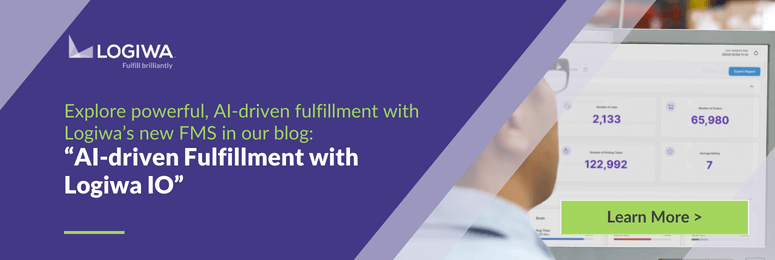Modern warehouses run on data. Your warehouse can get that data from your systems, workers, customers, and shipping partners. You can then store and leverage it to improve processes and decision-making.
However, making the most of your data requires connecting all your warehouse systems to exchange data. For example, integrating your entire tech stack with your warehouse management system will allow you to conveniently monitor multiple warehouse processes from one location (the WMS).
What’s your best option for integrating your warehouse tech? There are two key options: a webhook or an API. The webhook vs. API debate can be difficult to make sense of since both solutions are excellent for integrating tech.
In this guide, we break down what webhooks and APIs are, how they’re different, and which one you should choose.
First, here are some key takeaways you must know about webhooks vs. APIs:
- Both webhooks and APIs facilitate data exchange between your apps and services. For example, you can exchange data between your WMS and accounting software.
- APIs facilitate bi-directional data exchange, while webhooks are for unidirectional (one-way) data sending.
- While APIs follow a request-response approach, webhooks follow an event-driven approach.
- Combining webhooks and APIs is more beneficial than relying on one of the solutions.
- Logiwa WMS offers both webhooks and APIs, and recommends a combination of both for the best performance.
Contents
What Is a Webhook?
A webhook is an effective and simple solution for integrating an application with another, allowing it to send data in real-time to the connected app. An application connected via a webhook will only transfer data after a specific event triggers it, and the data transfer is immediate.
However, webhooks are only suitable for one-way data communication. The source application can send data to the designated endpoint (integrated app or tool) but not vice versa.
For example, your WMS can receive real-time data from integrated applications with a webhook. The seamless connection allows you to receive automatic updates on your WMS as soon as an event occurs.
Benefits of Webhooks
Below are the biggest advantages of using webhooks for integrating your warehouse tech:
- Real-time updates: Webhooks facilitate real-time and automatic data transfer from your WMS to integrated apps. The connection facilitates receiving instant notifications when specific events occur in the integrated systems.
- Reduced server load: Webhooks have a lower server load than APIs because they only send data when events happen. A lower server load reduces the risk of connected systems running slower.
- Simplified implementation: Webhooks are easier and quicker to set up than APIs. This means integrating apps with a webhook takes less time and effort.
- Data integrity: Delays in data transfer can compromise data integrity. Webhooks prevent data discrepancies by processing data and providing updates immediately after an event occurs.
How Webhooks Work
Below is a breakdown of the process through which webhooks connect systems and send data:
- Trigger event: Systems connected via a webhook can’t communicate data until a specific event occurs. For example, an ERP can’t receive data about a shipment from your WMS until that shipment occurs.
- Payload generation: Once the event occurs, the originating system or source application will connect to the endpoint or destination application via the webhook URL. The source application will then create a data payload containing relevant information about the event. Next, it will send the payload to the destination application.
- Processing by receiver: The destination application will receive the payload, process the data, and extract the relevant event information. The application may then generate a notification to alert you about the event, or depending on the sent data, the destination application may take other actions. For example, the destination application may update its database or launch another automated process.

What Is an API?
An application programming interface (API) is a solution that allows software applications to connect and exchange data with each other. It provides a set of protocols that specify how connected applications can request and exchange data.
For example, a WMS API simplifies integrating your WMS with other warehouse systems so that the connected systems can continuously and seamlessly exchange data.
Benefits of APIs
To help you pick a webhook vs. API winner, here are the unique benefits of integrating warehouse applications or systems with an API.
- Bi-directional communication: APIs allow connected applications to send and receive data between one another, bi-directionally. Connected systems can pull data from one another to update their databases (data synchronization) or execute actions without human intervention.
- Full control: Developers can tailor APIs to retrieve and filter specific data. The customization ensures that your systems only exchange relevant data, preventing you from wasting system resources.
- User-friendly: Integrating applications with an API is hassle-free because the API has standardized protocols and data formats that allow you to plug and play with some basic understanding.
- Better security: APIs have authentication and access control mechanisms that ensure secure communication between authorized systems. The access control mechanisms can also stop connected apps from reading sensitive data.
- Data manipulation: API-connected applications can do more than exchange data. They can also update and delete information. These features make managing received data easier.
How APIs Work
Here’s a breakdown of how an API allows connected applications to interact and exchange information.
- API request: It starts with an application sending an API request to an integrated application. The request recipient (or the API provider) may authenticate the request before processing it.
- API processing: The API provider will process the API request, which may be to retrieve data, update records, or perform other operations. Once processed, the API provider will respond to the request by generating a response containing the requested data or outcome.
- Data transfer: Next, the API provider will send the requested data or outcome back to the client application via the internet. Upon receiving the response, the API request’s sender can process the data to complete its task.
Webhook vs. API: Differences Between the Two
You can’t pick a winner for the webhook vs. API debate without looking at the differences between each solution. Below are those key differences:
- Webhooks allow only one-way communication between connected apps. An API, on the other hand, allows connected apps to exchange data back and forth (bi-directional communication).
- Webhooks only send data if an event triggers the process. An API transfers data synchronously–one application requests data and waits for the request recipient to respond.
- Webhooks have a lower server load, while APIs cause higher server loads because connected apps send data back and forth.
- Implementing webhooks is quicker than implementing APIs because setting up APIs requires setting up request and authentication structures.
| Webhooks | APIs | |
| Communication Direction | One-way communication (data is sent from one app to another) | Bi-directional communication (data is exchanged between apps) |
| Trigger Mechanism | Data is sent only if an event triggers the process | Data transfer is synchronous–data is requested and responded to |
| Server Load | Lower server load | Higher server load due to bi-directional data exchange |
| Implementation | Quicker to implement | Requires more time for setup due to request and authentication structures |
When to Use Webhooks (With Examples)
Use webhooks when you only need to retrieve data from an app. Webhooks are also your best choice if you want real-time visibility of your warehouse processes.
For example, use webhooks to connect your WMS to:
- Shipping software and receive real-time updates regarding order shipping progress
- Warehouse robotics systems to get immediate updates if a robot fails or encounters issues
- Ecommerce systems to get alerts immediately after you ship an order
When to Use APIs (With Examples)
Use APIs when you want a fully integrated warehouse ecosystem. It’s also your best solution if you have software that needs a constant stream of data to function effectively.
Connecting all your warehouse tech to your WMS via APIs lets connected systems continuously synchronize data. This ensures that every connected system has updated information without you manually updating data entries.
In summary, connecting your WMS to other warehouse applications with an API can turn your WMS into a single source of truth. You can then monitor all your connected warehouse systems and processes via the WMS.
Webhook vs. API: Which Is Best?
The winner of the webhook vs. API contest depends on your needs and use cases. Both solutions are excellent for integrating systems and facilitating transferring data. However, APIs are better for setting up systems to exchange data with each other, while webhooks are sufficient if you need an app to send data without receiving it.
Since both solutions are effective and useful, we recommend using both to integrate your warehouse systems. For instance, use webhooks when you want real-time updates from an application and choose APIs when your apps need bi-directional data exchange to work.
Also, while webhooks are faster, you can use APIs to double-check that your connected systems are working as they should.
Do you need a WMS and cloud order fulfillment software that offers APIs and webhooks? If so, look no further than Logiwa. Our WMS platform’s open API and webhooks simplify connecting to your existing warehouse tech stack.
Warehouse systems that you can integrate with our WMS via APIs and webhooks include billing software, ecommerce platforms, shipping apps, robotics systems, and more.
Simplify WMS Integration with Logiwa
As we’ve shown, both APIs and webhooks can connect your warehouse systems to transfer and leverage data. It’s why Logiwa WMS comes prepackaged with an open API and webhooks for quickly and seamlessly connecting your existing warehouse applications.
Experience Logiwa’s capabilities for yourself today by requesting a demo.
Webhook vs. API FAQs
What’s the Key Difference Between Webhooks and APIs?
While APIs support bi-directional data exchange and data synchronization between applications, webhooks support only one-way data transfer.
What Are the Disadvantages of Using Webhooks Instead of APIs?
Since a webhook doesn’t support bi-directional data exchange, it isn’t ideal for synchronizing data between your applications. Also, webhooks are unsuitable for connecting warehouse systems that rely on exchanging data with other systems to operate.
Should You Use Webhooks With an API?
Yes, you should use webhooks with an API. Webhooks provide real-time event-driven notifications so you can receive immediate updates. APIs complement webhooks by allowing bi-directional communication between integrated apps, leading to synchronous data exchange.
Scale up B2C fulfillment operations with an integrated digital warehouse and fulfillment system
Warehouse Management
Modern digital WMS powers a modern fulfillment experience






